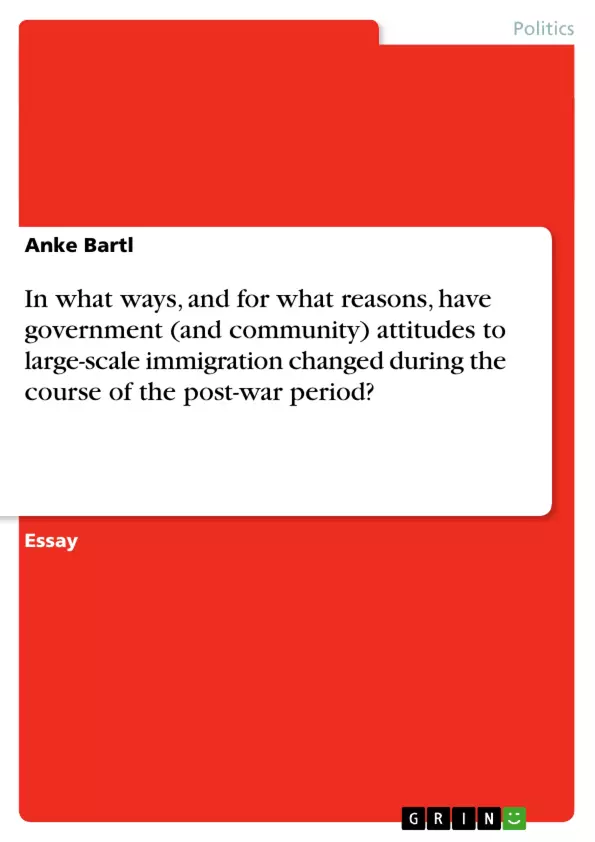This essay aims at explaining the changes in Australia’s immigration policy since
1945 and the reasons why governments have implemented major changes. The
steps involved in Australia’s movement from the White Australia Policy towards
multiculturalism will be examined chronologically.
In order to understand the importance of the changes after the Second Word War
it is necessary to take a brief look at what policy had been in place until then.
From the day of the first settlement in Australia, the country has always been an
immigrant society. With the exception of Indigenous Australians, everybody’s
ancestors have emigrated from various destinations to live on the continent down
under since 1788. Besides the German (largely in South Australia) and the
Chinese minorities, a majority of them had British or Irish origin.1
The first regulation implemented to secure who was – or rather who was not – to
enter the country is known as the White Australia Policy. This policy had a
tremendous effect on immigration in Australia. The roots of this policy go back to
the 1850s, when Chinese immigrants working in the mines in Victoria and New
South Wales were discriminated against and resented by the white population.2
This was largely due to racist theories like Social Darwinism and a fear of non-
Europeans that was strong enough to lead to the Commonwealth Immigration
Restriction Act of 1901. Although these words were never explicitly documented
in the policy, it aimed at excluding non-European immigrants. [...]
1 James Jupp, From White Australia to Woomera: The Story of Australian Immigration,
Cambridge University Press, Cambridge, 2002, p.5.
2 Department of Immigration & Multicultural & Indigenous Affairs, ‘Abolition of the ‘White
Australia’ Policy’, Fact Sheet 8, Canberra, 6 November 2002,
<http://www.immi.gov.au/facts/08abolition.htm>;, consulted 16 June 2003.
Inhaltsverzeichnis (Table of Contents)
- Introduction
- White Australia Policy 1901-1947
- Assimilationism 1947-mid 1960s
- Integration mid 1960s-1972
- Multiculturalism from 1972
- John Howard and the Liberal Party
- Current immigration schemes
- The Humanitarian Program
Zielsetzung und Themenschwerpunkte (Objectives and Key Themes)
This essay aims to examine the evolution of Australia's immigration policy since 1945, specifically focusing on the reasons behind the significant changes implemented by successive governments. The essay will chronologically analyze the transition from the White Australia Policy towards a multicultural society.
- Shifting government attitudes towards immigration
- The impact of the White Australia Policy on immigration
- The transition from assimilationism to multiculturalism
- The role of economic and political factors in shaping immigration policy
- The influence of international events and agreements on Australia's immigration policy
Zusammenfassung der Kapitel (Chapter Summaries)
- Introduction: This chapter provides a brief overview of the essay's objectives and the historical context of Australian immigration.
- White Australia Policy 1901-1947: This chapter discusses the origins and implementation of the White Australia Policy, highlighting its discriminatory nature and its impact on immigration patterns.
- Assimilationism 1947-mid 1960s: This chapter examines the assimilationist policies adopted after World War II, which aimed to integrate immigrants into a predominantly British society.
- Integration mid 1960s-1972: This chapter explores the gradual shift towards integrationist policies, acknowledging the growing diversity of the Australian population.
- Multiculturalism from 1972: This chapter discusses the adoption of multiculturalism as official government policy, recognizing the value of cultural diversity in Australian society.
- John Howard and the Liberal Party: This chapter analyzes the Liberal Party's approach to immigration under the leadership of John Howard, examining its policies and their impact.
- Current immigration schemes: This chapter provides an overview of contemporary immigration schemes in Australia, including the criteria for entry and the types of visas available.
- The Humanitarian Program: This chapter focuses on the humanitarian program, which provides refuge to individuals fleeing persecution and violence.
Schlüsselwörter (Keywords)
This essay explores key themes and concepts related to Australia's immigration policy, such as the White Australia Policy, assimilation, integration, multiculturalism, economic growth, political influence, and humanitarianism. It examines the historical evolution of immigration policies and the factors driving these changes.
- Arbeit zitieren
- Anke Bartl (Autor:in), 2003, In what ways, and for what reasons, have government (and community) attitudes to large-scale immigration changed during the course of the post-war period?, München, GRIN Verlag, https://www.hausarbeiten.de/document/16260


